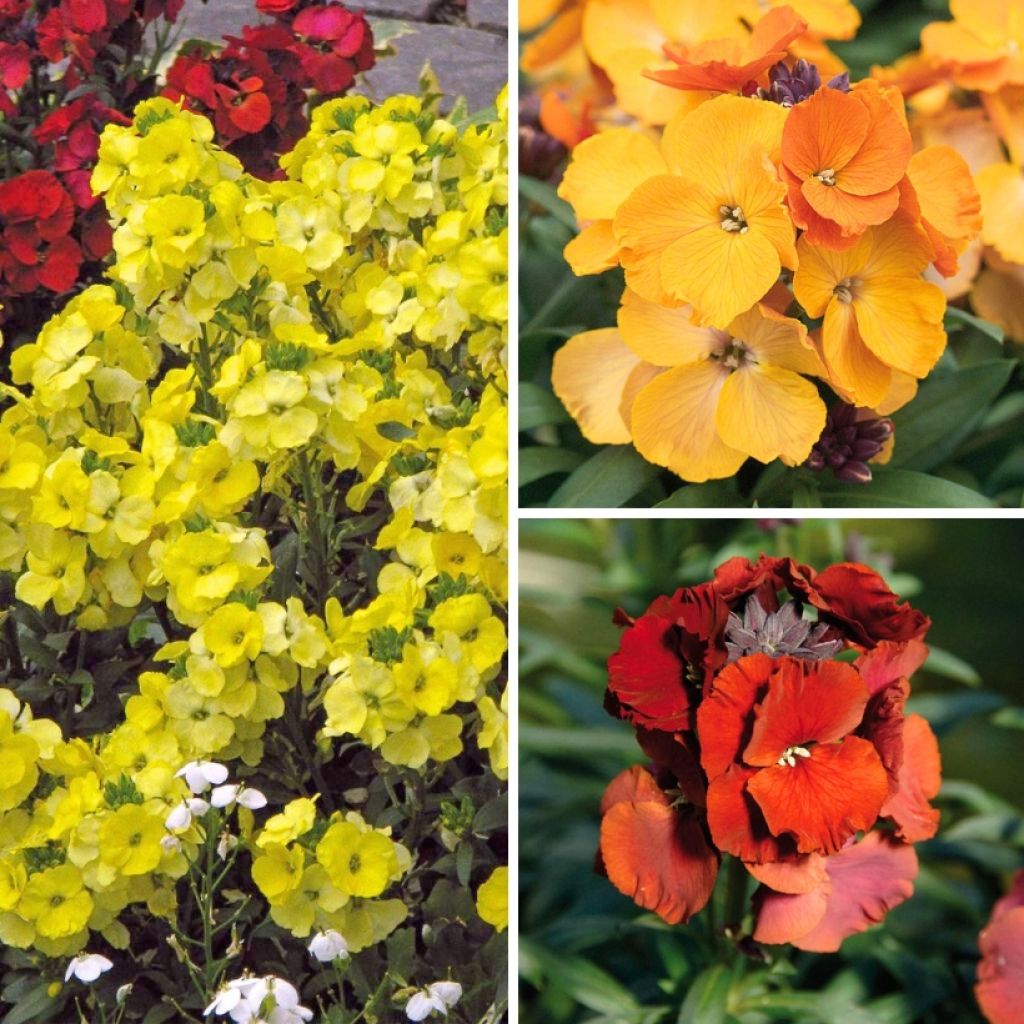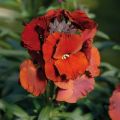

Erysimum Collection Warm Tones - Wallflower
Erysimum Collection Warm Tones - Wallflower
Erysimum (x) hybrida Rysi Copper, Winter Passion, Winter Light
Wallflower, Perennial Wallflower
This plant carries a 6 months recovery warranty
More information
We guarantee the quality of our plants for a full growing cycle, and will replace at our expense any plant that fails to recover under normal climatic and planting conditions.
From €5.90 for pickup delivery and €6.90 for home delivery
Express home delivery from €8.90.
Delivery to Corse prohibited: UE law prohibits the import of this plant from mainland France to Corse as part of the fight against Xylella fastidiosa. Please accept our sincere apologies.
More information
Does this plant fit my garden?
Set up your Plantfit profile →
Collection items (9 plants)
Description
Collection of 3 varieties of perennial Wallflowers (Erysimum) selected for their large, fragrant flowers in warm tones that bring much joy after winter. These plants bloom generously from March and continue flowering until June without requiring pruning. Naturally ramified, these plants are 35-40 cm (14-16in) tall and form small bushy clumps, which have a great effect in planters and spring flower beds.
The collection consists of:
3 plug plants of Erysimum 'Rysi Copper': a superb variety of false Wallflower with large, highly fragrant flowers in a soft yet powerful coppery orange colour.
3 plug plants of Erysimum 'Winter Passion': fragrant, velvety flowering in rich coppery red tones.
3 plug plants of Erysimum 'Winter Light': fragrant flowering in a palette of soft yellow, between lemon and primrose.
These perennial Wallflowers are sterile varieties propagated by cuttings. They form a well-branched small bush from the base, slightly taller than wide, covered with persistent, dark green foliage. The flowering and its fragrance are typical of common Wallflowers found in traditional gardens, with the difference that the flowers are twice as large and have a unique colour that cannot be altered by sowing. These plants appreciate light and well-drained, even rocky, but still nutrient-rich soil, as they are very demanding and require regular fertiliser to thrive.
This collection of Wallflowers is ideally suited for cultivation in pots, planters, and flower beds, but also in large displays. They can be combined with yellow or white daffodils, tulips in warm tones (Harmony of Light Tulips), and early-flowering perennials such as candytufts, saxatile alyssum, rock cress, etc., not to mention plants with decorative foliage such as heucheras or bronze carex.
Note: Please note that our young plug plants are professional products intended for experienced gardeners: upon receipt, transplant them as soon as possible in pots, planters, or directly in flower beds.
Report an error about the product description
Flowering
Foliage
Plant habit
Botanical data
Erysimum
(x) hybrida
Rysi Copper, Winter Passion, Winter Light
Wallflower, Perennial Wallflower
Cultivar or hybrid
Planting and care
Upon receipt, ideally in September, plant your plug plants of biennials in pots or large containers in a sunny location, or possibly partial shade. Pinch the tips of the main stem of the Erysimum 10 to 15 days after planting. They require a light and humus-bearing soil and appreciate fertiliser applications. In containers, biennials must be watered at planting and throughout the year, as the substrate should not dry out completely, even in winter. You can store them during winter on a balcony or a window sill protected from cold winds.
Planting period
Intended location
Care
This item has not been reviewed yet - be the first to leave a review about it.
Haven't found what you were looking for?
Hardiness is the lowest winter temperature a plant can endure without suffering serious damage or even dying. However, hardiness is affected by location (a sheltered area, such as a patio), protection (winter cover) and soil type (hardiness is improved by well-drained soil).

Photo Sharing Terms & Conditions
In order to encourage gardeners to interact and share their experiences, Promesse de fleurs offers various media enabling content to be uploaded onto its Site - in particular via the ‘Photo sharing’ module.
The User agrees to refrain from:
- Posting any content that is illegal, prejudicial, insulting, racist, inciteful to hatred, revisionist, contrary to public decency, that infringes on privacy or on the privacy rights of third parties, in particular the publicity rights of persons and goods, intellectual property rights, or the right to privacy.
- Submitting content on behalf of a third party;
- Impersonate the identity of a third party and/or publish any personal information about a third party;
In general, the User undertakes to refrain from any unethical behaviour.
All Content (in particular text, comments, files, images, photos, videos, creative works, etc.), which may be subject to property or intellectual property rights, image or other private rights, shall remain the property of the User, subject to the limited rights granted by the terms of the licence granted by Promesse de fleurs as stated below. Users are at liberty to publish or not to publish such Content on the Site, notably via the ‘Photo Sharing’ facility, and accept that this Content shall be made public and freely accessible, notably on the Internet.
Users further acknowledge, undertake to have ,and guarantee that they hold all necessary rights and permissions to publish such material on the Site, in particular with regard to the legislation in force pertaining to any privacy, property, intellectual property, image, or contractual rights, or rights of any other nature. By publishing such Content on the Site, Users acknowledge accepting full liability as publishers of the Content within the meaning of the law, and grant Promesse de fleurs, free of charge, an inclusive, worldwide licence for the said Content for the entire duration of its publication, including all reproduction, representation, up/downloading, displaying, performing, transmission, and storage rights.
Users also grant permission for their name to be linked to the Content and accept that this link may not always be made available.
By engaging in posting material, Users consent to their Content becoming automatically accessible on the Internet, in particular on other sites and/or blogs and/or web pages of the Promesse de fleurs site, including in particular social pages and the Promesse de fleurs catalogue.
Users may secure the removal of entrusted content free of charge by issuing a simple request via our contact form.
The flowering period indicated on our website applies to countries and regions located in USDA zone 8 (France, the United Kingdom, Ireland, the Netherlands, etc.)
It will vary according to where you live:
- In zones 9 to 10 (Italy, Spain, Greece, etc.), flowering will occur about 2 to 4 weeks earlier.
- In zones 6 to 7 (Germany, Poland, Slovenia, and lower mountainous regions), flowering will be delayed by 2 to 3 weeks.
- In zone 5 (Central Europe, Scandinavia), blooming will be delayed by 3 to 5 weeks.
In temperate climates, pruning of spring-flowering shrubs (forsythia, spireas, etc.) should be done just after flowering.
Pruning of summer-flowering shrubs (Indian Lilac, Perovskia, etc.) can be done in winter or spring.
In cold regions as well as with frost-sensitive plants, avoid pruning too early when severe frosts may still occur.
The planting period indicated on our website applies to countries and regions located in USDA zone 8 (France, United Kingdom, Ireland, Netherlands).
It will vary according to where you live:
- In Mediterranean zones (Marseille, Madrid, Milan, etc.), autumn and winter are the best planting periods.
- In continental zones (Strasbourg, Munich, Vienna, etc.), delay planting by 2 to 3 weeks in spring and bring it forward by 2 to 4 weeks in autumn.
- In mountainous regions (the Alps, Pyrenees, Carpathians, etc.), it is best to plant in late spring (May-June) or late summer (August-September).
The harvesting period indicated on our website applies to countries and regions in USDA zone 8 (France, England, Ireland, the Netherlands).
In colder areas (Scandinavia, Poland, Austria...) fruit and vegetable harvests are likely to be delayed by 3-4 weeks.
In warmer areas (Italy, Spain, Greece, etc.), harvesting will probably take place earlier, depending on weather conditions.
The sowing periods indicated on our website apply to countries and regions within USDA Zone 8 (France, UK, Ireland, Netherlands).
In colder areas (Scandinavia, Poland, Austria...), delay any outdoor sowing by 3-4 weeks, or sow under glass.
In warmer climes (Italy, Spain, Greece, etc.), bring outdoor sowing forward by a few weeks.






































